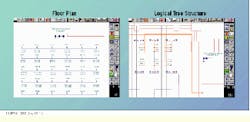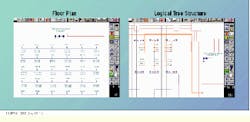Define end-user and contractor needs when implementing a CMS
As more organizations upgrade their cabling plants to standards-based structured cabling systems, the need for cable management systems has become evident.
William Spencer,
Network & Communication Technology Inc.
For most organizations upgrading their cabling plant, the primary objective is to support enterprise-wide, high-bandwidth, mission-critical applications to the desktop. Typical high-bandwidth applications include Ethernet and token ring topologies. Implementing a cable management system (CMS) to maintain the integrity of these important physical assets has now become a priority. A large number of requests-for-proposals (RFPs) for new cabling projects now incorporate CMS requirements -- often loosely defined. In addition, contractors may struggle when responding to these RFPs because they lack experience in providing cable management solutions. It is easy, therefore, for misunderstandings to occur due to differences in organizational expectations and contractor perceptions of a cable management solution.
To avoid this problem, both end-users and contractors need to have a clear understanding of exactly what is meant by "install a cable management system." Installing a CMS may be interpreted as just installing the software system on a computer at the customer`s site. However, it could also mean populating the database with information about the installed horizontal and riser cabling; documenting crossconnects at all administration points; documenting ports on all service equipment and tracking all circuits assigned and available; or documenting connectivity for all station equipment. Issues abound in the implementation of a CMS. For example: Should you document cable as a single record for each cable, or does the organizaton expect separate documentation for each twisted pair and for each fiber within every cable in the infrastructure? Most organizations need to define their cable management requirements more clearly, and contractors must be explicit when responding to a cable management RFP.
Establish organizational objectives
Several questions need to be answered when preparing or developing a response to a cable management RFP. Not only will these answers help define the company`s objectives, they will also clarify and determine the implementation requirements of the CMS, the type of system and the specifics of documentation required. Pertinent questions might include the following:
- Company objectives
- What is the organization doing now to manage its cabling infrastructure?
- Which departments or individuals have cable management responsibilities?
- Within the organization, who has requested a cable management solution, and what problem (if any) is that individual trying to solve?
- Has the organization specifically defined its cable management requirements?
- Does it plan to outsource the implementation of the CMS or the ongoing day-to-day cable management tasks?
- Are standards important to the organization?
- Will the CMS be linked to other accounting or management systems within the organization, and if so, how?
- What identification schemes for cabling and other assets are in place, and are these schemes suitable for cable management purposes; or will the contractor design a new identification scheme?
Implementation
- What are the end-user`s implementation and training expectations?
- Will implementation of the CMS include only the cabling installed by the contractor as defined under the RFP, or will documentation also be required for connections made after the installation?
- Will the CMS maintain pair and fiber detail or just the cable?
Note: Managing only the cable and not the pair detail can severely limit the usefulness of the CMS.
Type of system
- Does the company want a traditional database CMS or one that displays and produces physical documentation such as a graphical floor plan or logical (graphical tree structure ) documentation?
- How does the organization currently handle adds, moves and changes?
- Is trouble-ticketing, service-request and work-order management to be integrated into the CMS?
Documentation
- Does the organization plan to document the connectivity of circuits (services) to network equipment, and if so, when?
- What are the as-built drawing requirements of the CMS?
- What cabling and connectivity reports does the organization expect following implementation?
- What labeling requirements are included in the cable management specification?
- Will cable test results be documented within the CMS?
Perform site survey
Before you respond to an RFP, it is important to conduct a physical site survey and review the current cable and connectivity documentation. This includes a visit to each administration point within the organization`s infrastructure to become familiar with the overall premises infrastructure. If the building is older and has gone through an evolution of different types of cabling systems, make sure there are no surprises.
During a site survey, you can determine the number of administration points (closets and rooms) and the work areas (faceplate locations) you will need to document; the standard number of outlets at each work area; and the total outlets. You should also review how the wall fields in each telecommunications closet (TC) are organized. For example, are all services (voice, data, etc.) in the particular TC terminated on one set of horizontal connecting blocks or separate sets of horizontal blocks for each type of service? Does the organization have a standard for wall-field definition, and are the wall fields in all of the closets similar in layout? How are the cables and termination hardware labeled, and in what condition are the labels? Is documentation -- reports or drawings -- available in any of the TCs?
Take note of the overall condition of the TCs. If the customer wants a standards-based cable management solution, you can determine what changes need to be made in each closet to assure compliance.
After the site survey, arrange to meet with the appropriate staff within the organization to discuss organizational objectives, and explain the importance of an agreed-upon identification scheme when implementing the CMS. Next, you need to review the existing cable and connectivity documentation. If physical (floor plan) documentation is required, find out if drawings or computer-aided drawing (CAD) files showing horizontal cable routing are available. Decide together what the organization expects to do with existing obsolete and out-of-service cable. Determine the people within the organization who currently have authority or responsibility for cabling and cable management. From these discussions, you should also begin to understand clearly the organizational objectives and what the organizational structure for cable management will be in the future.
Defining project scope and costs
You cannot determine the cost of implementing a CMS until you have defined the scope of the project. A useful way to document the site survey and the scope (and therefore, the cost) of the project is to develop a checklist, or worksheet. A project worksheet helps ensure that there is no misunderstanding between the organization and the contractor as to what products and services are to be delivered.
To develop a project worksheet, you first need to know what cable, equipment and connectivity documentation exists, what cabling, equipment and connectivity you will have to inventory, and what cabling equipment and connectivity you will document in the CMS. In addition, you need to understand the customer`s labeling requirements: what labels you will produce and when the organization needs them. For example, are labels to be produced upon installation of the cabling or upon completion of implementation of the CMS?
Performing a physical inventory and documenting existing cabling, connectivity, service or station equipment can be time-consuming. Find out the amount of detail required before determining your costs. For example, the customer may require you to inventory and document peripherals and third-party boards associated with each computer, or to inventory and document users and services assigned to each pair of each cable in the CMS. Either of these cases would create a substantial increase in the time and costs required to perform these tasks.
The best way to develop the costs for performing a physical inventory or completing the documentation portion of the project is: First, determine the cost for a single transaction, such as routing horizontal cable to a work-area location; then multiply that cost by the total number of required transactions, such as work areas. If any special consulting tasks are required, provide a separate time-basis quote.
Final steps
There are a few additional steps you can take to ensure that implemention of the CMS goes smoothly. Always make sure that any existing documentation you use is complete and accurate and, if you plan to use existing CAD files to complete the project, examine at least one of the files to verify the file format and accuracy of the drawing content. Do not forget to include travel and living expenses for any technicians who will perform services at the site.
Confirm exactly what deliverables the organization expects upon completion of the project. It is always a good idea to include a sample set of drawings and reports that you will deliver upon completion of the project. Similarly, when you begin to implement the cable management project, be sure to prototype a small portion of the infrastructure and produce a complete set of deliverables for organizational approval before continuing.
This process will ensure that the identification scheme used meets the organization`s requirements and that it is satisfied with the drawings and reports produced. Now that you are sure there are no misunderstandings, you can complete the cable management project.
Cable management system software can produce and display physical documentation, such as a floor plan (left), or logical documentation, such as a tree structure (right).
William Spencer is president at Network & Communication Technology Inc., Park Ridge, NJ, developers of Planet cable management software.

